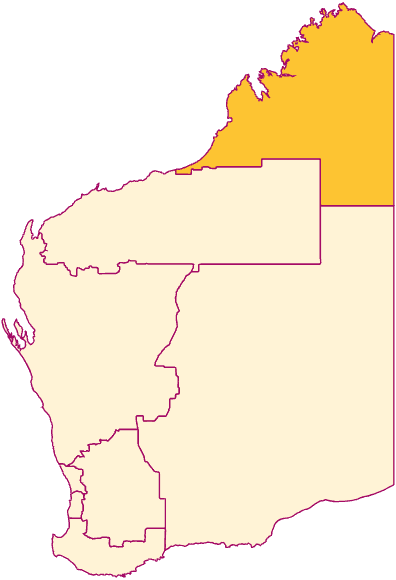Kimberley
Kimberley
The Kimberley region is nestled in the far north of Western Australia, where ancient landscapes stretch across vast expanses.
The Kimberley is a cultural treasure trove, presenting a deeply rewarding experience for educators passionate about making a difference. It has a population of over 39,000, made up of predominantly young people. Aboriginal people represent almost 50% of the population, compared to 2.5% of the nation’s population.
In this region, schools serve as pivotal hubs within communities, fostering close-knit relationships and collaboration to ensure positive student outcomes.
Find out what it's like to live and work in the Kimberley.

Teaching in the Kimberley presents an immensely rewarding opportunity for educators seeking a challenging yet fulfilling role.
Schools
Schools in this region offer a dynamic environment for both professional and personal growth, with a unique chance to profoundly impact the lives of students and their communities.
Broome is the largest town in the region and boasts several primary schools and a senior high school. There are 12 remote schools spread throughout the region and Kimberley communities are well supported by several district high schools. These environments offer a unique opportunity for teachers to expand their careers.
Students
With over 30 traditional Aboriginal language groups represented, Kimberley schools welcome students from varied backgrounds and schooling experiences. Cultural sensitivity and a deep understanding of familial and communal dynamics are crucial for establishing trust and fostering productive relationships with students, their families, and the wider community.
Emphasising a supportive and culturally responsive approach, schools in the Kimberley region prioritise student engagement and the integration of Aboriginal culture and history through collaborative learning methods. Continuous professional development initiatives, focusing on explicit instruction and a cohesive teaching framework, underscore the educational landscape in the Kimberley.
Teachers and staff
Teachers in the Kimberley must be flexible, resilient, and collaborative, as they work closely with colleagues in diverse settings. The educational workforce comprises a blend of seasoned educators and those new to teaching or leadership roles, all driven by a shared passion for meeting the unique educational needs of their students, offering enthusiasm and support along the way.
Our staff also work in the Kimberley Education Regional Office in Broome, providing services and support to schools in the region, and at the Broome Residential College.
Living in the Kimberley is a unique adventure, far removed from Perth's bustle yet deeply rewarding in its untouched beauty and cultural richness.
Weather and climate
With its sub-tropical climate, the region experiences distinct wet and dry seasons. The dry season, from May to October, has clear skies and warm weather, drawing tourists worldwide to its captivating sights. In contrast, the wet season, spanning November to April, presents hot, humid conditions.
Towns and housing options
Most residents live in Broome and Kununurra, while others are scattered across smaller towns including Derby, Fitzroy Crossing, Halls Creek, and Wyndham.
Housing, provided for teachers (and some other eligible staff) through the Government Regional Officers Housing (GROH) program, offers housing designed to withstand the wet season and air conditioning subsidies are available.
Location and economy
Travelling from Broome to Perth is approximately a 2.5-hour flight or a 23-hour drive, while Kununurra to Perth is just over 3 hours by air or a 32-hour drive.
Broome Airport (BME) and Kununurra Airport (KNX) facilitate domestic flights year-round, connecting to Perth and Darwin, with additional direct flights to Brisbane and Sydney during the dry season (April to September).
The Kimberley's economy, driven primarily by mining, also encompasses agriculture, construction, tourism, and retail sectors. Broome and Kununurra offer a full spectrum of services, including dining, luxury accommodations, and vibrant tourism activities during the dry season, making living in the Kimberley a truly enriching experience.
History
With a history dating back approximately 65,000 years, the Kimberley is among Australia's earliest settled areas, steeped in the rich tapestry of Aboriginal culture and wisdom. It holds some of the continent's oldest rock art, estimated to be around 40,000 years old, offering a captivating glimpse into its ancient heritage.
Things to do
Spanning vast expanses, this region dwarfs many nations, stretching nearly 1.8 times the size of the United Kingdom. Here, pristine coastlines intertwine with ancient landscapes, boasting breathtaking beaches, rugged ranges, and endless gorges, grasslands, and waterways. For more inspiration, check out Tourism Australia's website and explore the Kimberley and North West1.
Each Kimberley town serves as a gateway to the region's natural wonders, from Broome's captivating beaches to Kununurra's stunning Lake Argyle, the majestic Mitchell Falls, and the myriad of gorges, waterfalls, and swimming holes adorning the iconic Gibb River Road.
National parks abound in the Kimberley, offering guided tours and public access areas for exploration. Locals relish hiking, swimming, and camping during the dry season, while fishing enthusiasts revel in the abundance of waterways during the wet. With its vast wilderness and minimal light pollution, the Kimberley presents unparalleled stargazing opportunities under expansive night skies.
Teaching in the Kimberley region means having this breathtaking landscape at your doorstep, offering endless opportunities for exploration and personal growth. As you embark on your teaching journey, you'll not only develop your career but also make a profound positive impact on the students and communities you serve, creating lasting connections in this remarkable corner of the world.
Tourism WA image credit
Location images for Western Australian education regions are from Tourism Western Australia.












